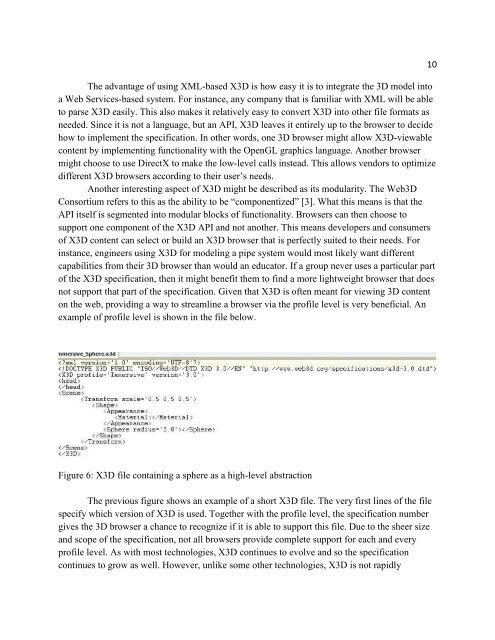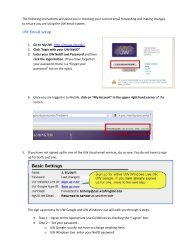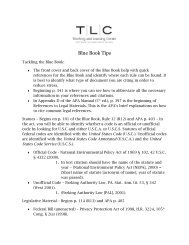1 Using Voxelization and Ray-Tracing to Identify Wall Thinness of ...
1 Using Voxelization and Ray-Tracing to Identify Wall Thinness of ...
1 Using Voxelization and Ray-Tracing to Identify Wall Thinness of ...
Create successful ePaper yourself
Turn your PDF publications into a flip-book with our unique Google optimized e-Paper software.
The advantage <strong>of</strong> using XML-based X3D is how easy it is <strong>to</strong> integrate the 3D model in<strong>to</strong>a Web Services-based system. For instance, any company that is familiar with XML will be able<strong>to</strong> parse X3D easily. This also makes it relatively easy <strong>to</strong> convert X3D in<strong>to</strong> other file formats asneeded. Since it is not a language, but an API, X3D leaves it entirely up <strong>to</strong> the browser <strong>to</strong> decidehow <strong>to</strong> implement the specification. In other words, one 3D browser might allow X3D-viewablecontent by implementing functionality with the OpenGL graphics language. Another browsermight choose <strong>to</strong> use DirectX <strong>to</strong> make the low-level calls instead. This allows vendors <strong>to</strong> optimizedifferent X3D browsers according <strong>to</strong> their user‟s needs.Another interesting aspect <strong>of</strong> X3D might be described as its modularity. The Web3DConsortium refers <strong>to</strong> this as the ability <strong>to</strong> be “componentized” [3]. What this means is that theAPI itself is segmented in<strong>to</strong> modular blocks <strong>of</strong> functionality. Browsers can then choose <strong>to</strong>support one component <strong>of</strong> the X3D API <strong>and</strong> not another. This means developers <strong>and</strong> consumers<strong>of</strong> X3D content can select or build an X3D browser that is perfectly suited <strong>to</strong> their needs. Forinstance, engineers using X3D for modeling a pipe system would most likely want differentcapabilities from their 3D browser than would an educa<strong>to</strong>r. If a group never uses a particular par<strong>to</strong>f the X3D specification, then it might benefit them <strong>to</strong> find a more lightweight browser that doesnot support that part <strong>of</strong> the specification. Given that X3D is <strong>of</strong>ten meant for viewing 3D conten<strong>to</strong>n the web, providing a way <strong>to</strong> streamline a browser via the pr<strong>of</strong>ile level is very beneficial. Anexample <strong>of</strong> pr<strong>of</strong>ile level is shown in the file below.10Figure 6: X3D file containing a sphere as a high-level abstractionThe previous figure shows an example <strong>of</strong> a short X3D file. The very first lines <strong>of</strong> the filespecify which version <strong>of</strong> X3D is used. Together with the pr<strong>of</strong>ile level, the specification numbergives the 3D browser a chance <strong>to</strong> recognize if it is able <strong>to</strong> support this file. Due <strong>to</strong> the sheer size<strong>and</strong> scope <strong>of</strong> the specification, not all browsers provide complete support for each <strong>and</strong> everypr<strong>of</strong>ile level. As with most technologies, X3D continues <strong>to</strong> evolve <strong>and</strong> so the specificationcontinues <strong>to</strong> grow as well. However, unlike some other technologies, X3D is not rapidly
















